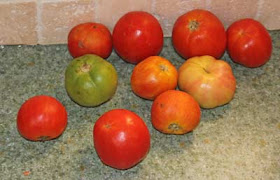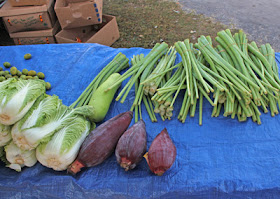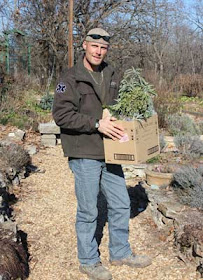 |
| Still eating this past summer's tomatoes. Today, Jan 1, these are all we have left. |
Eating Locally has become more than a fad, more than a movement, it is a major cultural shift for an increasing segment of our population. And it's not just something that's happening on the West and East Coasts, it's happening world wide. I saw how enormous this cultural shift had grown when I attended the International Slow Foods conference in Turin, Italy in 2005. People from 130 countries, 5,000 of us, were all there for the same purpose, to help make local food a priority in our own countries.
 |
| Carrie and Ron in Halloween attire. |
Long time friends of ours, Ron Zimmerman and Carrie Van Dyck, in their internationally acclaimed restaurant,
The Herbfarm, in Woodinville, Washington, serve only food that comes from 30 miles or less from their location. Even the salt on the tables is evaporated from sea water, nearby. Their extensive herb and vegetable gardens (and truffle pigs - truffles can be found in the Pacific Northwest and pigs are the best hunters) furnish their kitchen the year around. I admire that process, and to eat in their restaurant is the kind of indescribable dining experience you remember for the rest of your life. (If you can) imagine 9 courses, 7 wines and 6 hours of dining and one of the best times in your life.
 |
| The Herbfarm Restaurant, a remarkable place where everything you eat is from the local area. |
 |
| Just one course out of the 9 I had that night, every bite so good you want it to last forever. |
While I do my best to eat locally, some things simply aren't possible here. Oranges, for example, to grow my own would require expensive greenhouses and more energy than could be justified. Avocados, too, bananas, Cheerios, chocolate, beef, the list is long, of things that either aren't available locally, or impractical. But I like to try to keep things as local as possible, and our fall garden continues to feed us pretty well. Shown at the top of this post are the last of our summer-fall tomato crop, harvested from the garden as green tomatoes after Halloween and left on the kitchen counter to ripen slowly. We've eaten them all except for these (and the 16 pints of
Fish House Green Tomato Pickles I made - and included the recipe here on the blog; thanks for all your good comments from the pickles you made
from the recipe).
I'm currently working on my Heirloom Herbalist column for
The Heirloom Gardener magazine, and for the spring issue, I'm writing about growing black pepper. I got the idea recently while taking a shower - good ideas come while my mind is idle and soapy! I keep my black pepper plants in the bathroom because it has a heated tile floor and the temperature stays above 65 degrees. Black pepper requires that much heat in order to thrive and mine has burst into bloom in the past 2 weeks. I brought the plants back from a Florida trip 2 years ago and once I figured out what the plants need, they have done pretty well.
 |
| Black pepper (Piper nigrum) |
Black pepper is native to the southwestern coast of India, and the spice traders of the world, beginning in pre-Roman times, found their way to the pepper growers. It's a vine, grown clinging to tree trunks where it can reach 30-40 feet high. The plant requires filtered light, not direct sunlight, lots of heat and reliable moisture. If the soil temperature dips below 65 degrees F., the plant will drop its leaves. Over all, it's not a difficult plant to grow indoors and does great when it's moved outdoors in the shade in summer. Here's what the blooms look like at present on one of my plants.
 |
| The flowers grow along the stem, which is about 2 inches long. |
 |
| Black pepper vine on a wall with flowers. |
To give an idea of how tiny the flowers actually are
(each one will become one peppercorn), here is the flower stalk with flowers, next to the head of a straight pin, like you get when you buy a new shirt or garment.
 |
| The head of a pin, next to the pepper flowers. |
Normally the plant flowers in summer but the heated bathroom floor has hurried the process. I tried pollinating the flowers with a tiny watercolor brush but it is many times too large. Bees can't pollinate the flowers, so I'm guessing it must be pollinated by tiny moths or gnats. I doubt any of these will set fruit during the winter.
This is what the pepper berries should look like once the plant is pollinated. These, from last year, are ready for picking. Once picked, you drop them into boiling water for 5 minutes to split the skin of the berry, then they are placed in the food dehydrator for 3 or 4 days or until completely dry. Then the peppercorns are then ready for putting in the pepper mill and you're ready to season your food.
Malabar pepper comes from the region of Malabar in India and is the most common variety, and the least expensive. Tellicherry pepper is a larger, more robust flavored peppercorn and a bit more expensive. Green peppercorns are those that are picked before the pepper berries are completely ripe
(like the green ones in the photo to the left). White pepper is from the Malabar pepper and the berries have been boiled and the dark, outer skin removed. White pepper is the mildest of all of the peppercorns. Red peppercorns aren't pepper at all but are from a small tree in China.
Pepper is grown in Brazil, Vietnam and other areas but all of the pepper varieties were originally from India. Pepper is grown within 15 degrees of either side of the equator, areas with 100 inches of rainfall per year, high humidity and temperatures, and where the plants can be grown on the trunks of trees. However, the plant makes a fairly good houseplant, with the benefit of providing you with black pepper for the table. Happy new year ahead of each of you from us here at
Long Creek Herbs!






















































